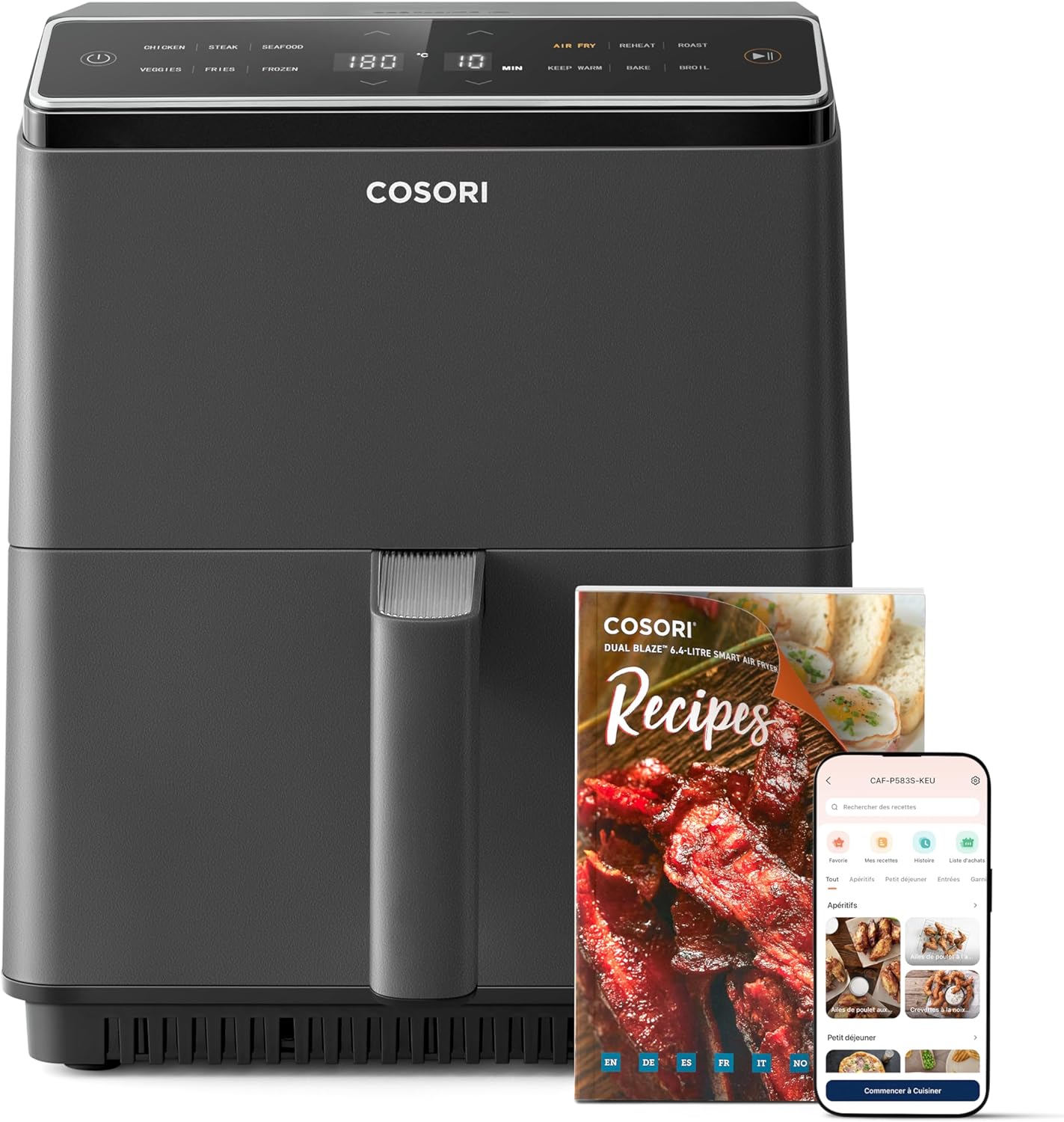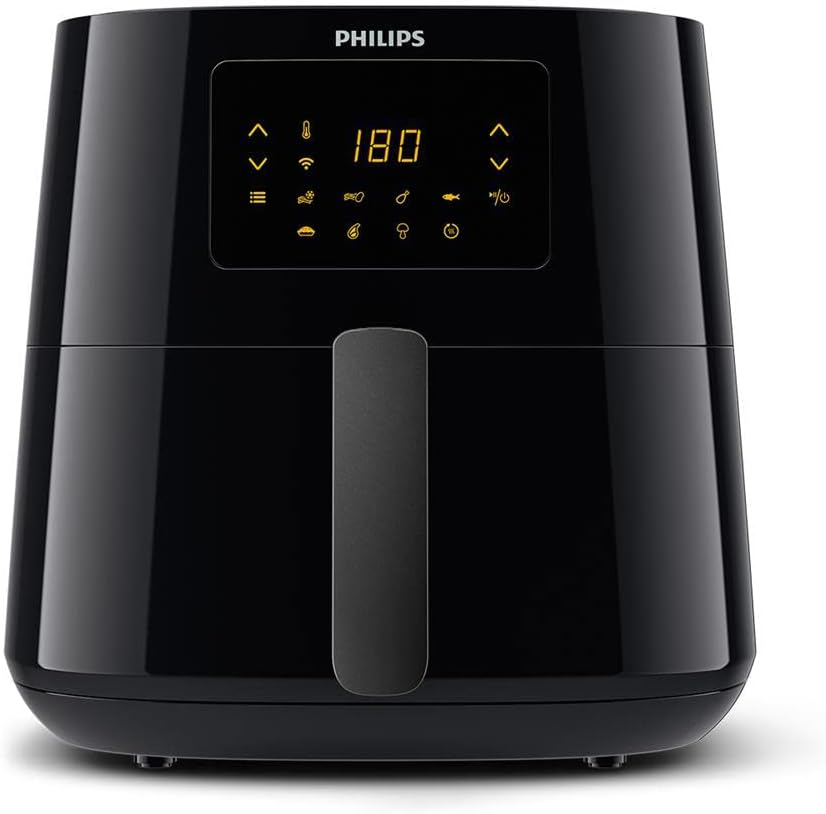Some kitchen gadgets quietly take over your daily routine—and the air fryer might just be the champion of that category. If you’ve ever tried tossing frozen fries into one and watching them come out golden without a drop of oil, you know the magic. But not all air fryers are created equal. And if you’re down to choosing between the Cosori Dual Blaze and the Philips Airfryer Serie 5000 XL, you’ve got a real decision on your hands.
Both are high-powered, smart-enabled appliances. Both promise crispy results. But only one feels like it’s been obsessively fine-tuned for performance, while the other leans into minimalist elegance. We’ve had them side by side on the counter—tested them with veggies, wings, battered fish, and late-night frozen snacks. The differences are subtle in some places, but they count. Let’s get into the details.
Same footprint, different personality
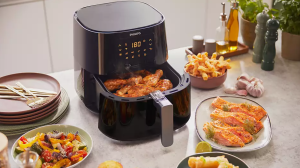
You might not think looks matter in an air fryer—until you realize it’s now taking up permanent space on your kitchen counter. And this is where the personalities of these two devices start to diverge.
The Cosori Dual Blaze looks more utilitarian, almost like a kitchen tank. It’s got sharp lines, a squat form, and feels heavier and more solid when you interact with it. The control panel is on top, which means you’re looking straight down at it, a natural motion when standing.
The Philips Airfryer Serie 5000 XL has a more refined aesthetic. Its curved edges, smoother silhouette, and front-facing touchscreen give it a sleeker profile, more in line with the rest of your kitchen appliances. But yes—you’ll be bending slightly to check the display.
Neither one is huge, and both are meant for countertops. But Cosori feels a bit more bulky, while Philips plays the visual trick of looking smaller than it is.
Capacity and power: the numbers that matter (a little)
This is where things seem closer than they are. Cosori offers 6.4 liters of cooking capacity, just edging out Philips with its 6.2 liters. If you’re cooking for four to six people regularly, both will get the job done without juggling multiple batches.
On the wattage front, Philips runs at 2000 watts, versus Cosori’s 1700 watts. That sounds like a big deal, but in practice, preheating times and cook durations didn’t differ much. The real story isn’t power—it’s how that power gets used. And that’s where the game shifts.
Cosori’s secret weapon: dual heating elements
Let’s talk heat—because this is where things really split. Cosori’s Dual Blaze is named for its biggest trick: two heating elements, one on top and one below. That alone changes the game. It means heat surrounds the food more evenly, and you rarely have to stop and shake halfway through.
The 360 ThermoIQ tech adjusts temperature in real time using dual sensors, constantly monitoring for consistency. No cold spots, no burnt edges, no soggy middles—it’s the kind of heat control that takes the stress out of the process.
Philips, by contrast, uses its well-established Rapid Air technology, which swirls hot air in a circular motion. It works well—the airflow is strong, and cooking is impressively even, especially considering it relies on a single upper heating element. But it doesn’t quite match the precision you get from Cosori’s dual-heat strategy.
That said, Philips offers a wider temperature range, starting as low as 60°C and climbing to 200°C, which opens the door to low-temp applications like dehydrating or gentle reheats. Cosori’s focus is more on speed and consistency, while Philips leaves a bit more room for experimentation.
More buttons or fewer? Depends on how you cook
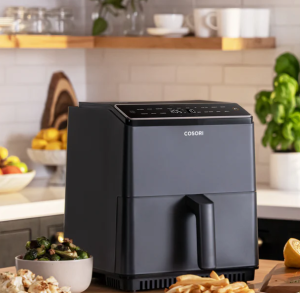
User interface might sound boring—until you’re standing there mid-cook trying to remember how to reheat leftovers.
Cosori gives you 12 preset programs, and they’re all clearly labeled with their own dedicated buttons. There’s one for fries, one for chicken, one for steak, and so on. You also get function-based modes like bake, broil, reheat, roast, plus a keep warm function that we started using constantly.
Philips offers just 7 presets, and it keeps the interface clean and minimal. It covers the essentials: frozen food, fries, fish, meat, poultry, vegetables, and cake. The rest is up to you—and if you’re a confident cook, you might appreciate the stripped-down layout. But for fast, one-tap cooking, Cosori’s layout is easier to use without thinking.
In short: Cosori’s UI is better for automation. Philips is better if you like to take the wheel.
Smart controls that don’t feel like gimmicks
Both brands know that remote control is more than a luxury—it’s a time-saver. And both have WiFi connectivity and smartphone apps that let you start, stop, and schedule cooking remotely.
Cosori connects via the VeSync app, which is clean, responsive, and focused. You can pick a program, monitor progress, and adjust temperature and time all from your phone. It doesn’t try to be flashy—it just works, without friction.
Philips uses its NutriU app, which is more content-heavy. It includes recipes, cooking suggestions, and lets you customize cooking programs. It leans into the idea of being part of a larger Philips ecosystem, so if you’ve got other smart kitchen gear from the brand, this app will feel like home.
In terms of function? They’re equals. But in feel, Cosori’s app is more utilitarian, while Philips offers more discovery.
Practical features you’ll appreciate daily
No air fryer is useful if it’s annoying to clean or hard to manage. Luckily, both of these come through on the practical stuff.
Removable baskets are dishwasher-safe, with non-stick coatings that genuinely make post-dinner cleanup painless. Cool-touch handles are standard, and both have built-in safety shut-off features and overheat protection. You’ll also get a shake reminder during longer cooking sessions, though thanks to Cosori’s dual heating, you’ll often skip that step anyway.
But here’s the thing that surprised us: neither model includes a viewing window. It’s not a dealbreaker, but it’s a feature we would’ve liked, especially since opening the drawer mid-cook resets the temp slightly in both.
Where Philips flexes its culinary finesse
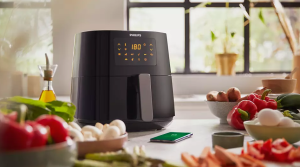
While Cosori wins on brute precision and speed, Philips quietly offers a few tricks of its own. That wider temperature range we mentioned? It’s ideal for slow cooking or reheating leftovers gently without drying them out. It also does a great job with delicate foods—like flaky fish or pastries—that can be ruined by overzealous top heat.
So if your cooking habits lean toward finesse over force, or if you want something that feels more “chef-y” than “gadgety,” Philips has a certain elegance to its performance.
The verdict? It depends who’s cooking
If we had to boil this down to one line: Cosori Dual Blaze is for people who want to set it and forget it. Philips is for people who want to take the reins.
Cosori’s dual heating elements, bigger preset menu, and simplified interface make it feel faster and more automated. It doesn’t ask you to learn much—it just does what you need, fast and with fewer touchpoints. It’s also ever so slightly larger in capacity, which helps when you’re feeding a crowd.
Philips, on the other hand, is the smoother operator. It doesn’t have the same firepower under the hood, but its airflow system is polished, its app is more exploratory, and it handles nuanced cooking styles with more grace. The lower temp range and wider mode flexibility make it a better fit for experimental cooks.
But let’s be clear: if consistency, convenience, and daily ease of use are your top priorities, Cosori wins. Hands down.
That said… maybe one day they’ll just add a damn viewing window.

